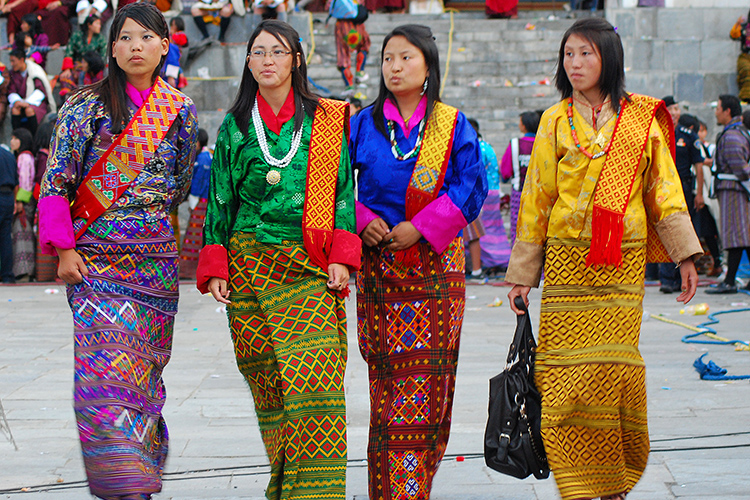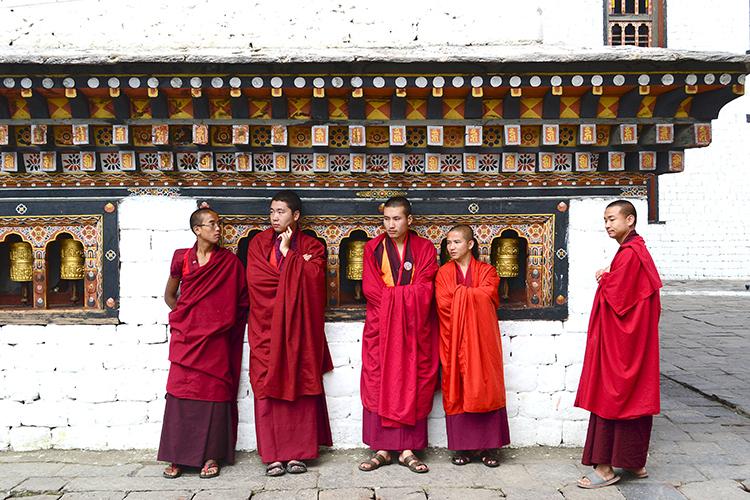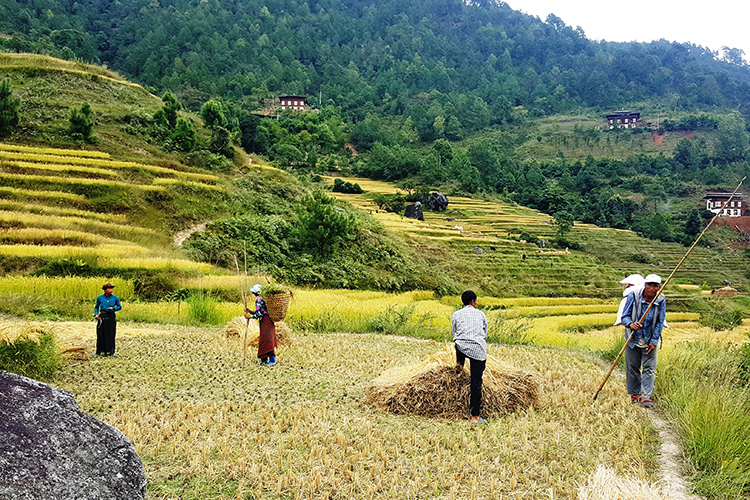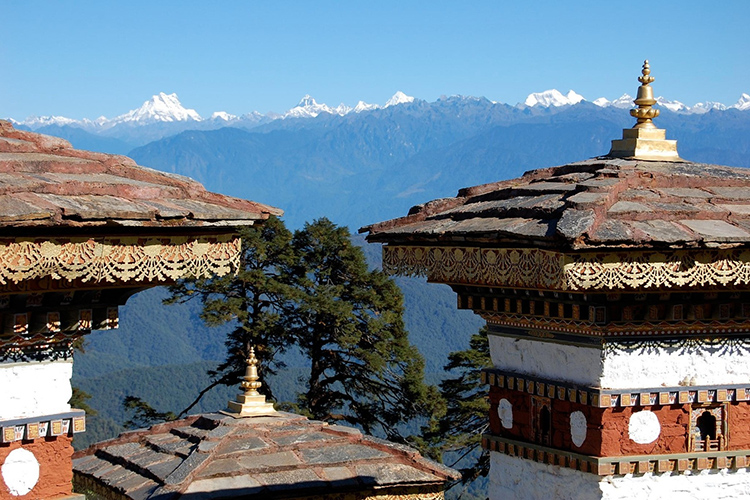Beguiling Bhutan
The Kingdom of Bhutan – aka The Dragon Kingdom, The Land of the Thunder Dragon, The Last Shangri-La - is a stunningly beautiful, gentle, landlocked country sandwiched between China, Tibet and India, in the eastern Himalayas. Having been closed to tourism for years, it has a mystical aura and remains relatively unvisited. Remaining largely isolated from the outside world and the global impact of tourism until the 20th century has helped preserve its distinct cultural heritage, and allowed its people to maintain their traditional way of life. The monarchy has played a significant role in Bhutan's history, with successive kings guiding the country's development and preserving its unique identity. As a nation it is developing fast with infrastructure coming on in leaps and bounds – they are taking the best from modernised countries and doing it their way! As a result, it is now a wonderfully comfortable kingdom to travel in whilst, at the same time, one feels one is being transported back in time. Life is beautifully slow here!

The history of Bhutan is deeply intertwined with its Buddhist heritage. The country was unified in the 17th century by Zhabdrung Ngawang Namgyal, a Tibetan lama who established a theocratic system of governance. Zhabdrung played a crucial role in unifying the country and promoting Buddhism. His legacy is still revered today, and his teachings continue to influence Bhutanese society. The Royal Family have always been held in great esteem but in 2008 Bhutan became the world’s youngest democracy with the monarchy themselves choosing to give up absolute constitutional monarchy. Today the current, young King is much admired and revered and plays an integral part in making Bhutan ‘work’.
With a population of approximately 800,000 people, Bhutan is a small but vibrant nation with a rich history and distinct identity. The people of Bhutan, known as Bhutanese, are primarily of Tibetan and Nepalese descent and are warm, friendly and deeply connected to their cultural values and traditions. The national dress, known as the "Gho" for men and "Kira" for women, is worn with pride on a daily basis by many Bhutanese, representing their cultural identity. The official language is Dzongkha, although numerous regional dialects are spoken throughout the country. Bhutanese society is deeply rooted in Buddhist traditions, and Buddhism plays a central role in the lives of the people who place great emphasis on spirituality, mindfulness, and environmental conservation. Indeed, the concept of Gross National Happiness (GNH), coined by the fourth king of Bhutan, Jigme Singye Wangchuck, reflects the country's commitment to holistic development, prioritizing happiness and well-being over material wealth. This extraordinary country has a unique approach to development which includes policies such as preserving the environment, promoting cultural heritage, and ensuring equitable socio-economic progress.
Buddhism in Bhutan is a way of life rather than just a religion, with monasteries and temples serving as welcoming spiritual centres and community hubs for all. One of the most iconic cultural landmarks in Bhutan is the dzong, a fortress-like structure that serves as both a religious and administrative centre. These architectural marvels are scattered throughout the country – perched on hills, clinging to cliff sides, sitting on a spur in a river, sunk deep in a valley or lying in an open plain - with some of the most famous ones being Punakha Dzong, Paro Dzong, and Trongsa Dzong. Dzongs also host vibrant festivals and religious ceremonies, with traditional music and dance, such as the Boedra and Zhungdra, being cherished forms of artistic expression. Buddhist monks and nuns hold a respected position in society and are highly revered for their spiritual guidance and teachings.

The monastic education system, known as the "Dratshang," is an important aspect of Bhutanese culture, providing education and moral guidance to the younger generation. Religious festivals, or tshechus, are an integral part of Bhutanese culture, celebrated with great fervour, enthusiasm and joy. These festivals are vibrant and colourful, featuring masked dances, music, and religious rituals. Tshechus are held throughout the country throughout the year so it is easy to time a visit to coincide with one of these fascinating moments.
Bhutanese textiles and craftsmanship hold great importance in the country's cultural heritage. The intricate weaving of kiras (women's traditional dress) and ghos (men's traditional dress) is a skilled art form passed down through generations. Bhutanese textiles are known for their vibrant colors, intricate patterns, and exquisite craftsmanship. Each region in Bhutan has its distinct style and motifs, showcasing the diversity within the country's textile traditions.

This stunning small land is renowned for its breathtakingly dramatic landscapes, ranging from subtropical plains to deep valleys and towering peaks. Only 186 miles long and 93 miles wide, it is roughly the size of Switzerland. In the southern region, the fertile subtropical plains gradually rise from the Indian border and give way to the green, rolling foothills of the Himalayas which slowly become glistening, high peaks – many remaining snow covered throughout the year. The central region consists of deep valleys carved out by rivers, surrounded by steep mountains and lush forests with a vast array of species – deforestation does not exist here and it’s a joy to encounter dense, virgin forest wherever you travel.
Bhutan's northern region is where the majestic Himalayas dominate the landscape. Here, snow-capped peaks, including the iconic Mount Jomolhari, reach for the sky. The highest peak in Bhutan, Gangkhar Puensum, stands at a towering 7,570 meters (24,840 feet).
The rugged mountain terrain is interspersed with deep gorges, glacial lakes, and pristine rivers. The valleys and plateaus of Bhutan are dotted with fertile agricultural land, where rice, maize, wheat, and other crops are cultivated. The varied geography of Bhutan contributes to its rich biodiversity and it is recognized as a global biodiversity hotspot, boasting a wide variety of ecosystems and rare species. Bhutan has a strong commitment to environmental conservation, with over 70% of its land designated as protected areas which serve as ideal habitats for a huge range of flora and fauna, including the endangered Bengal tiger, snow leopard, and black-necked crane.
The topography and geography of Bhutan also plays a role in shaping its climate which varies significantly. The country is divided into three regions: the southern plains have a subtropical climate with hot and humid summers with heavy rainfall during the monsoon season (Aug-Sept); while the central valleys have a temperate climate with pleasant summers and cold winters. As you move northward, the northern Himalayas have an alpine climate with long, harsh, snowy winters and cool summers. The country experiences a range of climates, from subtropical in the south to alpine in the high mountain regions.

Hospitality is embedded in the Bhutanese people and their cuisine is based on simplicity, specific spices, and the use of local ingredients. The staple food of Bhutan is red rice, which is often accompanied by a variety of spicy and savoury dishes. Chilli peppers are a prominent ingredient in Bhutanese cuisine, and the national dish, Ema Datshi, consists of chili peppers cooked with cheese. Other popular dishes include momo (dumplings), phaksha paa (pork cooked with spices), and suja (butter tea). Traditional Bhutanese meals often feature a variety of side dishes, including vegetables, meat, and dairy products and boasts a unique blend of cuisine and a diverse climate that significantly influences its culinary traditions.
The variation in climate also directly influences the availability of ingredients and the types of crops grown in different regions of Bhutan. In the southern regions, tropical fruits such as bananas, oranges, and pineapples thrive, while the central valleys are suitable for cultivating grains, vegetables, and fruits like apples and peaches. In the higher altitudes of the Himalayas, buckwheat, barley, and potatoes are common crops due to the cooler climate. This diversity in climate also plays a role in shaping the culinary preferences of the Bhutanese people. Spicy and warming dishes are favoured in the cooler regions, while lighter and refreshing dishes are preferred in the warmer areas.
Why waste life on escaping when you can experience instead?! That is what Bhutan is all about – a rare and memorable experience for those who make the effort to get there.
